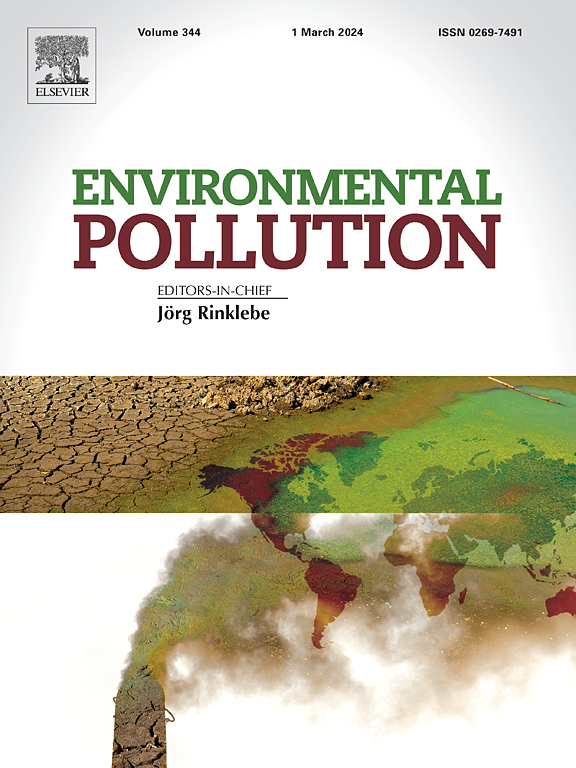地下和地上地铁站的含铁颗粒有什么不同?
IF 7.6
2区 环境科学与生态学
Q1 ENVIRONMENTAL SCIENCES
引用次数: 0
摘要
含铁颗粒种类(如金属铁、磁铁矿和赤铁矿)在确定毒性方面起着关键作用,但很少有研究比较地上和地下地铁站。本研究采用多种方法,包括磁测量、扫描电镜(SEM)和地球化学方法,分析了这些环境中含铁颗粒的丰度和种类。结果表明,地下平台的总铁(23.2±4.5 wt%)比地上平台(7.7±0.9 wt%)高约3倍。磁铁矿衍生铁(Femag)在地下站点中的含量(47±4%)明显高于地上站点(22±2%),而硅酸盐衍生铁(Fer)在地上平台中的含量(8.8±0.9%)明显高于地下站点(4.2±1.6%)。多种证据,包括磁性、扫描电镜成像和铁元素分析,证实了站台粉尘中含铁颗粒的两个主要来源:城市表土/街道灰尘和车轮/轨道磨损。城市表土/街道粉尘对地上站点的影响更大,而对地下站点的影响主要是轮轨磨损。这些发现为毒理学研究提供了重要的见解,强调了都市环境中颗粒组成的可变性。本文章由计算机程序翻译,如有差异,请以英文原文为准。

What differences between underground and aboveground metro stations in iron-bearing particles are?
Iron (Fe)-bearing particle species (e.g., metallic Fe, magnetite, and hematite) play a critical role in determining toxicity, yet few studies compare aboveground and underground metro stations. This study employed multiple approaches, including magnetic measurements, scanning electron microscopy (SEM), and geochemical methods, to analyze the abundance and species of Fe-bearing particles in these environments. Results reveal that total Fe in underground platforms (23.2 ± 4.5 wt%) is approximately three times higher than in aboveground platforms (7.7 ± 0.9 wt%). The proportion of magnetite-derived Fe (Femag) is significantly greater in underground stations (47 ± 4%) compared to aboveground stations (22 ± 2%), while silicate mineral-derived Fe (Fer) is more abundant in aboveground platforms (8.8 ± 0.9%) than underground (4.2 ± 1.6%). Multiple lines of evidence, including magnetic properties, SEM imaging, and Fe species analysis, confirm two primary sources of Fe-bearing particles in platform dust: urban topsoil/street dust and wheel/rail abrasion. Urban topsoil/street dust more likely influenced aboveground stations, whereas underground stations was mainly impacted by wheel/rail abrasion. These findings offer key insights for toxicological research, emphasizing particle composition variability in metro environments.
求助全文
通过发布文献求助,成功后即可免费获取论文全文。
去求助
来源期刊

Environmental Pollution
环境科学-环境科学
CiteScore
16.00
自引率
6.70%
发文量
2082
审稿时长
2.9 months
期刊介绍:
Environmental Pollution is an international peer-reviewed journal that publishes high-quality research papers and review articles covering all aspects of environmental pollution and its impacts on ecosystems and human health.
Subject areas include, but are not limited to:
• Sources and occurrences of pollutants that are clearly defined and measured in environmental compartments, food and food-related items, and human bodies;
• Interlinks between contaminant exposure and biological, ecological, and human health effects, including those of climate change;
• Contaminants of emerging concerns (including but not limited to antibiotic resistant microorganisms or genes, microplastics/nanoplastics, electronic wastes, light, and noise) and/or their biological, ecological, or human health effects;
• Laboratory and field studies on the remediation/mitigation of environmental pollution via new techniques and with clear links to biological, ecological, or human health effects;
• Modeling of pollution processes, patterns, or trends that is of clear environmental and/or human health interest;
• New techniques that measure and examine environmental occurrences, transport, behavior, and effects of pollutants within the environment or the laboratory, provided that they can be clearly used to address problems within regional or global environmental compartments.
 求助内容:
求助内容: 应助结果提醒方式:
应助结果提醒方式:


